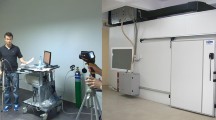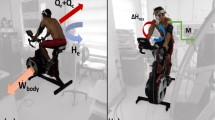Abstract
The authors studied the influence of exercise with a submaximal intensity on the thermal state, gas and energy exchange, cardiovascular system, exercise capacity, and subjective status in 11 track-and-field athletes in two microclimatic regimens (temperature and relative humidity of the air 21 ± 1°C and 78 ± 3% vs. 31 ± 1°C and 80 ± 2%). The character and manifestation of functional shifts in the subjects' bodies highly depended on the conditions of heat exchange with the environment. Based on these results, the authors recommended a minimum complex of physiological criteria for regulating the duration of work with preset intensity under conditions of impeded heat dissipation.
Similar content being viewed by others
REFERENCES
Akhundov, K.M. and Rips, M.K., Influence of High Outer Temperature on the Adaptation of an Athlete's Body to Muscular Activity, Teor. Prakt. Fiz. Kul't., 1984, no. 4, p. 25.
Kots, Ya.M., Sportivnaya fiziologiya (Physiology of Sports), Moscow: Fizkul'tura i Sport, 1986.
Balakin, V.I., Thermal State and Energy Exchange during Man's Adaptation to Muscular Activity, Abstract of Doctoral (Biol.) Dissertation, Ryazan', 1994.
Nadel, E.R., Limits Imposed on Exercise in a Hot Environment, Catorade Sports Sci. Exch., 1990, no. 3, p. 27.
Maxwell, N.S., Aitchison, F.C., and Nimma, M.A., The Effect of Climatic Heat Stress on Intermittent Supramaximal Running Performance in Humans, Exp. Physiol., 1996, no. 5, p. 833.
Galloway, S.D.R., Shirrefs, S.M., Leiper, J.B., and Maughan, R.J., Exercise in the Heat: Factors Limiting Exercise Capacity and Methods for Improving Heat Tolerance, Sports Exercise and Injury, 1997, no. 1, p. 27.
Wilmore, J.H. and Costill, D.L., Physiology of Sport and Exercise, Springfield, Ill.: Human Kinetics, 1994.
Aulik, I.V., Opredelenie fizicheskoi rabotosposobnosti v klinike i sporte (Determination of Exercise Capacity for Clinical and Athletic Purposes), Moscow: Meditsina, 1990, 2nd Ed., Revised and Supplemented.
Ramzaev, P.V., Methods of Thermoelectric Measurements in a Hygienic Experiment, Gigiena i Sanitariya, 1960, no. 7, p. 64.
Dembo, A.G. and Zemtsovskii, E.V., Sportivnaya kardiologiya: rukovodstvo dlya vrachei (Athletic Cardiology: A Manual for Physicians), Leningrad: Meditsina, 1989.
Azhaev, A.I., Fiziologo-gigienicheskie aspekty deistviya vysokikh i nizkikh temperature (Physiological and Hygienic Aspects of the Effect of High and Low Temperatures), Moscow: Nauka, 1979, pp. 198–199.
De Vries, H.A. and Housh, T.J., Physiology of Exercise, Brownand Benchmark, 1979, 5th ed.
Zinochkin, V.A., The Problem of Evaluation and Prognosis of Heat Tolerance in the Man, Abstract of Cand. Sci. (Med.) Dissertation, Moscow, 1979.
Koshcheev, V.S. and Kuznets, E.N., Fiziologiya i gigiena individual'noi zashchity cheloveka v usloviyakh vysokikh temperature (Physiology and Hygiene of Individual Protection of the Man under Conditions of High Temperatures) Moscow: Meditsina, 1986.
Author information
Authors and Affiliations
Rights and permissions
About this article
Cite this article
Bakulin, V.S., Makarov, V.I. & Brezhnev, S.D. Physiological Criteria of Regulating the Duration of Physical Work with Submaximal Power under Conditions of Limited Heat Dissipation. Human Physiology 28, 333–337 (2002). https://doi.org/10.1023/A:1015565004496
Issue Date:
DOI: https://doi.org/10.1023/A:1015565004496




